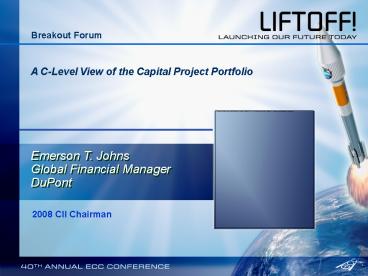A CLevel View of the Capital Project Portfolio PowerPoint PPT Presentation
1 / 21
Title: A CLevel View of the Capital Project Portfolio
1
Breakout Forum
A C-Level View of the Capital Project Portfolio
Emerson T. Johns Global Financial Manager DuPont
2008 CII Chairman
2
Capital Expenditures
- Corporate Executive and Investment Community
perspectives - Critical issues and expectations
- What this means to the EC industry
3
2007 U.S. Construction Spending
Private Construction (875 billion) Public
Construction (286 billion)
(Source U.S. Census Bureau News) 2006 Global
construction expenditures 4.6 trillion
4
Capital ExpendituresCEO and CFO
Perspectives-Examples
- Maintain a strong balance sheet
- Drive sustained profitable growth globally
- Satisfy shareholder expectations (e.g., Cash Flow
Return on Investment, i.e., CFROI) - Capital allocation process
- Manage risk
- Sustainability
- Dependence/reliance on technology
- Attracting the right talent (and keeping them) to
improve business outcomes - Adapt to change and respond strategically (speed,
flexibility, adaptability) - Having an effective capital execution process
- Ensuring new assets operate efficiently and
effectively - Containing costs (minimize delays, overruns,
etc.)
5
Capital ExpendituresInvestment Community
Perspective-Examples
- Key Metric Cash Flow Return on Investment
(CFROI) - Grow high return businesses
- Enhance your ability to increase (or hold on to)
high returns - may be new products or new
features that allow you to price higher - Give you a competitive advantage that you can
translate into pricing and/or higher market share - Improve fixed asset utilization
- Allow you to reduce inventory
- Make an asset more functional i.e., improve
operating performance and improve returns on that
asset
6
Financial Planning-Capital Investments
- Cash Flow Measures
- Net Present Value (NPV) the value of forecast
cash flows if discounted to the present at a
given discount rate. - Internal Rate of Return (IRR) financial return
realized over the life of an investment. - Profitability Index (PI) present value of
future cash inflows generated by project divided
by present value of cash outflows. - Discounted Payback (DP) measures the time
required for projected cash flows from a proposed
investment, discounted at the cost of capital, to
equal the initial cash outflow. - Cash Flow Return on Investment (CFROI)
measures return on capital on a cash basis
metric useful to assess the quality of a
particular investment compared to other
investment choices (e.g., RD)
7
Financial Planning-Capital Investments
- Capital Investment Financial/Business Case
Learnings - Business case analysis (market, pricing, and
other key assumptions) - Cash flow metrics (original project premise
versus actual) - Application of learnings to future projects,
capital allocation decisions, and risk management
process
8
Financial ManagementCapitalKey Metrics
- Business Team
- Net Present Value (NPV) and Internal Rate of
Return (IRR) - Discounted Payback Period
- Profitability Index
- Project Team
- Expenditures (capital and non-capital)
- Schedule
- Safety
- Operability/Quality
- Impact of project on operations Cost of
Manufacturing (e.g., maintenance, reliability,
energy, environmental, yields, uptime, etc.) - Corporate
- Capital Allocation
- Shareholder Value Add (SVA) and Return on Net
Assets (RONA) - Return on Equity (ROE)
- Reports on Accomplishment
9
Capital Expenditures
- Risk - A Leaders Concern
10
Capital Risk
Laws and Regulations
Ethics and Business Conduct
Financial Controls
Operational Controls
11
Facilities Engineering Process
Products That Continuously Meet Global Customer
Needs Requirements Better Than
All Competitive Products
Global Customer Needs
Business Objectives, Capital Forecasts
Project Basis, Capital Budget
Production Des Basis, CAC, Project Auth
Competitive Facility That Meets Business Needs
Project Planning FEL-3
Business Planning FEL-1
Facility Planning FEL-2
Facility Operation
Project Implementation
Front-End Loading
Execution/Operation
Owner Audits
Owner Leads
Owner Leads
Contractor Involved
Contractor Leads
Contractor Supports
Risk
12
Few Projects Meet All Objectives
(Source IPA benchmarking data)
13
Capital Expenditures Examples of Modern Day Risks
- Loss of reputationbusiness scandals
- Currency
- Energy
- Globalization
- Business drivers
- Natural and man-made disasters (e.g., industrial
accidents, transport calamities) - Creation of new potential hazards
- Blow-ups of markets and firms
- Terrorism
- Epidemics (SARS)
- Escalation
- Risks of omission, implementation, operational,
legal, technology, intellectual property, project
management, credit, political, human assets,
compliance
14
Reactions to Risks
- Litigation and law suits
- Government regulation (e.g., Sarbanes-Oxley)
- Homeland Security
- Some say too much time spent on small decisions
and not enough on big ones - Some businesses become more risk-averse others
benefit by managing risk effectively - Higher insurance costs
- Some governments take a more cost-benefit
approach others put more emphasis on precautions
(better safe than sorry) - Contingencies
- Withdraw from business or market
15
Examples of Risk Management Tools and Services
- Project Front-end Loading and Gatekeeping
- Processes
- Decision and Risk Analysis
- Real Options Analysis
- Risk Based Asset Management
- _at_RISK
- International Project Risk Assessment (CII)
- CSFB HOLTs CFROI (First Boston)
- Scenario-Based Project Planning (FIATECH)
- IPA (BFEL)
- Maturity Model
- Consultants, Accounting Firms
- Expert Judgment
16
Conclusion
The revolutionary idea that defines the boundary
between modern times and the past is the mastery
of risk Peter Bernstein Against the Gods
17
CapitalWhat Does Capital Management Entail?
- Strategic Planning
- Setting Objectives
- Raising Capital
- Product Pricing
- Financial Risk Management
- Liability Valuation
- Asset Allocation
- Risk Management
18
Financial ManagementCapital
19
Capital Expenditures Trends
- Work Force and Human Capability
- Project Delivery
- Corporate Strategy
- Technology/Innovation
- Markets/Demand Drivers
- Social/Political Drivers
20
Capital ExpendituresChallenges for Owners and
the EC Industry
- Competitiveness
- Work force development (Engineering professionals
and leaders, crafts) - Safety
- Research
- Sustainability
- Productivity (what are the right metrics)
- Cycle Time
- Effectiveness efficiency (competiveness) of
assets created - Technology (Bio processes, nano technology,
carbon emissions, potential water crisis, energy) - Project Team Credibility
- Globalization (including global markets,
international competition, materials
availability, pricing impact, resource
availability, etc.)
21
A C-Level View of the Capital Project Portfolio
Thank You
Emerson T. Johns DuPont September 5, 2008

